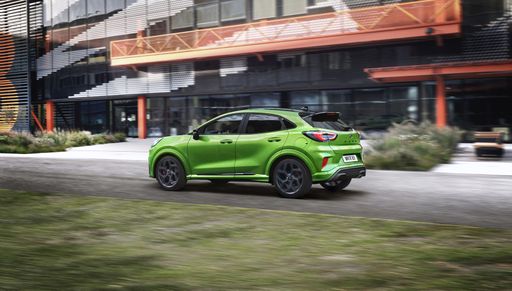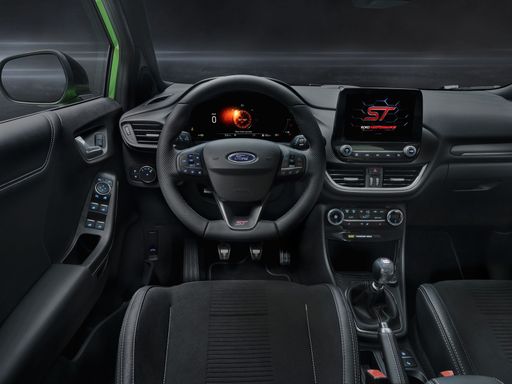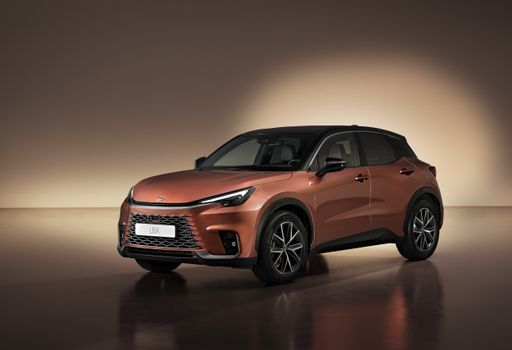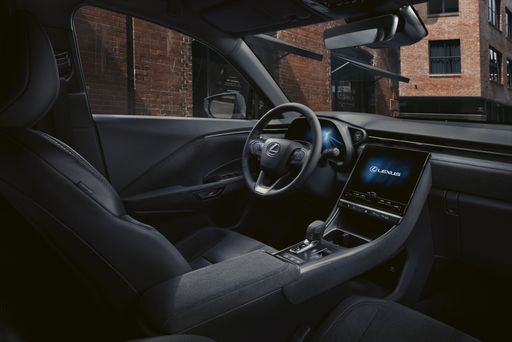In a world where compact SUVs are the perfect blend of practicality and style, the Ford Puma and Lexus LBX emerge as competitors worth analyzing. While both vehicles embody the spirit of the SUV segment, their approach to design, technology, and performance significantly distinguishes them. Let’s dive deep into a comprehensive comparison of these two models.
Ford Puma vs Lexus LBX – Differences & prices compared
Everyday use, family trips or long-distance drives – here’s where the differences show.
Discover whether Ford Puma or Lexus LBX fits your lifestyle better.
Design and Dimensions
The Ford Puma is available in two distinct lengths: 4186 mm and 4226 mm. With a width of 1805 mm and a height of 1550 mm, the Puma's sporty stance complements its design. The sharp lines and aggressive front fascia speak to Ford’s modern styling language, appealing to those who seek a dynamic presence on the road.
On the other hand, the Lexus LBX measures 4190 mm in length and is slightly wider at 1825 mm, while standing at 1560 mm in height. Lexus’s design philosophy shines through, emphasizing luxury and sophistication. The signature spindle grille and sleek LED lighting contribute to its upscale aesthetic, distinguishing it from the more utilitarian appearance of the Puma.
Powertrains and Performance
Under the hood, the Ford Puma offers a range of engine options, including MHEV petrol and fully electric variants. The petrol engines range from 125 to 168 hp, demonstrating its capability for spirited drives and efficient performance. With acceleration times as low as 7.4 seconds from 0-100 km/h and a top speed reaching 210 km/h, the Puma caters to performance enthusiasts.
Conversely, the Lexus LBX utilizes a full hybrid system that generates 136 hp. This engine delivers fuel efficiency, with consumption ratings as low as 4.5 L/100 km. Although not the fastest in straight-line acceleration, completing 0-100 km/h in 9.2 seconds offers a respectable performance for its class. Its top speed is capped at 170 km/h, aligning with its focus on efficiency and urban driving.
Technology and Innovations
Both models incorporate cutting-edge technology, but the approach varies. The Ford Puma is equipped with a user-friendly infotainment system, offering seamless smartphone integration and a feature-rich digital cockpit. Innovations such as Ford’s Co-Pilot 360, featuring advanced safety systems, elevate the driving experience and provide additional peace of mind on the road.
Meanwhile, Lexus is synonymous with luxury and technology. The LBX features a comprehensive infotainment setup that integrates voice recognition and a premium audio system, ensuring passengers enjoy the ride in style. Additionally, Lexus Safety System+ includes a suite of driver-assist technologies designed to enhance safety, showcasing Lexus's commitment to passenger protection.
Interior Space and Comfort
Inside, the Ford Puma seats five occupants comfortably, providing a spacious cabin with a cargo capacity ranging from 456 to 523 liters, depending on the configuration. The emphasis is on practicality, with versatile seating and ample storage solutions, making it an ideal choice for families and city dwellers alike.
In contrast, the Lexus LBX is designed to accommodate four passengers, with a focus on luxury rather than sheer capacity. The trunk capacity of 332 liters may seem modest compared to the Puma, but the premium materials and craftsmanship inside elevate the overall experience. Lexus prioritizes comfort with ergonomically designed seats and a quiet cabin, ensuring a serene driving experience.
Conclusion: Which SUV Reigns Supreme?
The decision between the Ford Puma and Lexus LBX ultimately depends on individual preferences and needs. If you value agility, versatility, and performance, the Puma is a formidable choice. Conversely, if luxury, hybrid efficiency, and advanced technology are your priorities, the Lexus LBX might just be the perfect fit. Both vehicles are stellar options in the compact SUV landscape, showcasing the evolving demands of modern consumers.
Here’s where it gets real: The technical differences in detail
Costs and Efficiency:
Price and efficiency are key factors when choosing a car – and this is often where the real differences emerge.
Ford Puma has a to a small extent advantage in terms of price – it starts at 24800 £, while the Lexus LBX costs 28300 £. That’s a price difference of around 3506 £.
Fuel consumption also shows a difference: Lexus LBX manages with 4.50 L and is therefore clearly perceptible more efficient than the Ford Puma with 5.40 L. The difference is about 0.90 L per 100 km.
Engine and Performance:
Power, torque and acceleration are the classic benchmarks for car enthusiasts – and here, some clear differences start to show.
When it comes to engine power, the Ford Puma has a to a small extent edge – offering 168 HP compared to 136 HP. That’s roughly 32 HP more horsepower.
In acceleration from 0 to 100 km/h, the Ford Puma is noticeable quicker – completing the sprint in 7.40 s, while the Lexus LBX takes 9.20 s. That’s about 1.80 s faster.
In terms of top speed, the Ford Puma performs to a small extent better – reaching 210 km/h, while the Lexus LBX tops out at 170 km/h. The difference is around 40 km/h.
There’s also a difference in torque: Ford Puma pulls distinct stronger with 290 Nm compared to 185 Nm. That’s about 105 Nm difference.
Space and Everyday Use:
Whether family car or daily driver – which one offers more room, flexibility and comfort?
Both vehicles offer seating for 5 people.
In curb weight, Lexus LBX is barely noticeable lighter – 1280 kg compared to 1316 kg. The difference is around 36 kg.
In terms of boot space, the Ford Puma offers evident more room – 523 L compared to 332 L. That’s a difference of about 191 L.
In maximum load capacity, the Ford Puma performs evident better – up to 1283 L, which is about 289 L more than the Lexus LBX.
When it comes to payload, Lexus LBX barely noticeable takes the win – 475 kg compared to 469 kg. That’s a difference of about 6 kg.
Who wins the race?
The Ford Puma proves to be wins the duel decisively and therefore becomes our DriveDuel Champion!
Ford Puma is the better all-rounder in this comparison.
 @ Ford Motor Company / Ford Media Center
@ Ford Motor Company / Ford Media Center
Ford Puma
Ford Puma
The Ford Puma is a cheeky compact crossover that blends sporty styling with city-friendly practicality, giving drivers a surprisingly fun and composed ride. With clever storage tricks and a lively personality, it’s a smart pick for buyers who want enjoyment without fuss.
details @ Ford Motor Company / Ford Media Center
@ Ford Motor Company / Ford Media Center
 @ Ford Motor Company / Ford Media Center
@ Ford Motor Company / Ford Media Center
 @ Ford Motor Company / Ford Media Center
@ Ford Motor Company / Ford Media Center
 @ Ford Motor Company / Ford Media Center
@ Ford Motor Company / Ford Media Center
Lexus LBX
The Lexus LBX wraps premium touches and a surprisingly spacious cabin into a compact crossover that’s perfectly at home in town or heading out on longer drives. It wears the badge with quiet confidence, serving up a refined ride and clever packaging for buyers who want Lexus polish without shouting for attention.
details @ Lexus / Toyota Motor Corporation
@ Lexus / Toyota Motor Corporation
 @ Lexus / Toyota Motor Corporation
@ Lexus / Toyota Motor Corporation
 @ Lexus / Toyota Motor Corporation
@ Lexus / Toyota Motor Corporation
 @ Lexus / Toyota Motor Corporation
@ Lexus / Toyota Motor Corporation
 @ Ford Motor Company / Ford Media Center
@ Ford Motor Company / Ford Media Center
|
 @ Lexus / Toyota Motor Corporation
@ Lexus / Toyota Motor Corporation
|
|
|
|
Costs and Consumption |
|
|---|---|
|
Price
24800 - 36300 £
|
Price
28300 - 40000 £
|
|
Consumption L/100km
5.4 - 5.9 L
|
Consumption L/100km
4.5 - 4.8 L
|
|
Consumption kWh/100km
13.1 - 13.9 kWh
|
Consumption kWh/100km
-
|
|
Electric Range
361 - 376 km
|
Electric Range
-
|
|
Battery Capacity
43 kWh
|
Battery Capacity
-
|
|
co2
0 - 135 g/km
|
co2
102 - 110 g/km
|
|
Fuel tank capacity
42 L
|
Fuel tank capacity
36 L
|
Dimensions and Body |
|
|---|---|
|
Body Type
SUV
|
Body Type
SUV
|
|
Seats
5
|
Seats
5
|
|
Doors
5
|
Doors
5
|
|
Curb weight
1316 - 1563 kg
|
Curb weight
1280 - 1365 kg
|
|
Trunk capacity
456 - 523 L
|
Trunk capacity
255 - 332 L
|
|
Length
4186 - 4226 mm
|
Length
4190 mm
|
|
Width
1805 mm
|
Width
1825 mm
|
|
Height
1550 - 1555 mm
|
Height
1560 mm
|
|
Max trunk capacity
1216 - 1283 L
|
Max trunk capacity
992 - 994 L
|
|
Payload
367 - 469 kg
|
Payload
455 - 475 kg
|
Engine and Performance |
|
|---|---|
|
Engine Type
Electric, Petrol MHEV
|
Engine Type
Full Hybrid
|
|
Transmission
Automatic, Manuel
|
Transmission
Automatic
|
|
Transmission Detail
Reduction Gearbox, Manual Gearbox, Dual-Clutch Automatic
|
Transmission Detail
CVT
|
|
Drive Type
Front-Wheel Drive
|
Drive Type
Front-Wheel Drive, All-Wheel Drive
|
|
Power HP
125 - 168 HP
|
Power HP
136 HP
|
|
Acceleration 0-100km/h
7.4 - 9.8 s
|
Acceleration 0-100km/h
9.2 - 9.6 s
|
|
Max Speed
160 - 210 km/h
|
Max Speed
170 km/h
|
|
Torque
170 - 290 Nm
|
Torque
185 Nm
|
|
Number of Cylinders
3
|
Number of Cylinders
3
|
|
Power kW
92 - 124 kW
|
Power kW
100 kW
|
|
Engine capacity
999 cm3
|
Engine capacity
1490 cm3
|
General |
|
|---|---|
|
Model Year
2025
|
Model Year
2025
|
|
CO2 Efficiency Class
A, D
|
CO2 Efficiency Class
C
|
|
Brand
Ford
|
Brand
Lexus
|
Is the Ford Puma offered with different drivetrains?
The Ford Puma is offered with Front-Wheel Drive.
The prices and data displayed are estimates based on German list prices and may vary by country. This information is not legally binding.
